Learn how to sew a slipcover for a wingback chair with this step by step video tutorial.
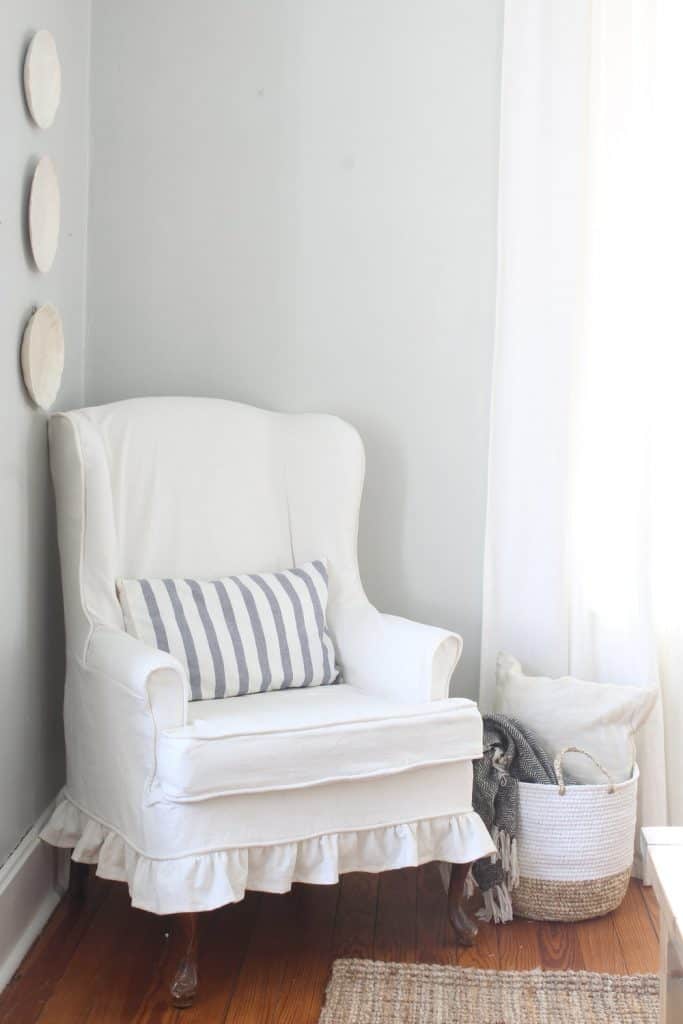
This post contains affiliate links for your shopping convenience. See my full disclosure HERE.
A Challenging Project
I have been sewing simple things for years now; dresses for my little girls, pillows, curtains, throw blankets and even simple slipcovers for our living room couches.
But, I must admit, this project challenged me.
This project was hard, but with patience and perseverance (and a few choice words) totally doable!
How to Slipcover a Wingback Chair Supplies
For this slipcover I used painter’s drop cloth that I bleached, a process I described in this post.
The drop cloth I use can be found HERE.
UPDATE MUST READ: I have heard from several readers that the brand of drop cloth you buy makes all the difference. I did not know this, since I have only ever used this brand from Amazon. Other brands turns gray and off white.
UPDATE PART TWO: Thanks to Lori, a lovely reader of my blog, I now know why some other brands won’t turn white. The drop cloths I recommend from Amazon are 100% cotton, so bleachable. Some brands are made with 50% polyester, so unbleachable. I knew people were having trouble with other brands, but now I actually know why!
Slipcovering is more about the process than an actual step by step tutorial.
To slipcover anything you just need to follow these rules
1. Follow the original seams and lines of the chair/couch/love seat
2. If you are adding piping, use the original chair as your guide. Put it in all the places that the original maker of the chair put it.
3. Pin the fabric tightly to the chair
4. Use a lot of pins and sew often.
This is not a quick process. You will want your chair near your sewing machine, so you can continually go back and forth to make sure everything is fitting okay.
You never want to pin and sew several seams at one time.
Always pin a little, sew it, and return to the chair to pin a little more.
Taking care to go slowly will ensure an excellent fit!
How To Slip Cover a Wingback Chair Instructions
To begin, I made enough piping to get me through the whole project.
To do this, I sandwiched 6/32″ cotton cord inside a four inch strip of bleached drop cloth.
I used a zipper foot to get the needle as close to the cord as possible, without sewing over it.
Next, I cut and draped all the pieces over the chair. (This will make waaay more sense in the video.) I cut pieces for the outside and inside of the wing, two pieces for the back, two pieces for the arms, two pieces for the front of the arms, two outside lower pieces, a piece for the front apron and a large piece for the front chair back (if that makes any sense at all).
I totally guesstimated all the sizes of the pieces.
Nothing has to be exact. The exactness will come with the pinning and sewing. 🙂
I started by overlapping the two back pieces and pinning them (right sides together) to the chair back piece.
It is really important to keep the chair back piece smooth and tight. It will the most visible in the finished slipcover.
Following the lines and seams of the original chair, I pinned the outside wing pieces to the back and to the inside wing pieces, which I also pinned to the front of the chair piece.
Have I lost you? It will make sense in the video.
You can see how many pins I used in this process. I wanted to be sure they would follow the lines of the chair, ensuring a nice fit.
I made sure the pins created a line for me to sew along.
While slipcovering I stop several times to be sure everything is still fitting.
Sometimes things may appear a bit wonky but might actually turn out when you pull it taut at another seam.
And remember that mine looked like it wasn’t going well halfway through, but turned out totally fine!
I could tell that I wasn’t going to have quite enough bleached drop cloth to finish my project, so I used unbleached drop cloth for the portion that would be hidden underneath the cushion.
Notice in the photo below how all the seams of my slipcover are along the original seams of the chair.
Use the piece as your guide.
This will allow you to slipcover anything.
After the main portion of the slipcover was finished, I added a ruffle and piping to the bottom edge to finish it off.
For the cushion, I created an envelope style cover, as opposed to using a zipper.
To make the pattern, I traced the shape of the cushion onto the drop cloth, leaving about a half inch on all sides for seam allowance.
For the bottom part of the cushion I cut two pieces that would overlap each ther for the cushion to fit inside.
I also cut a long strip that would go around the center of the cushion to join together the top and bottom pieces, with piping sandwiched between.
If you are on the fence about trying this, I encourage you to do it! As long as you go slow and check the fit often, you can totally do this.
You will be so proud of yourself for tackling the slipcover. 😉
You got this!
How to Sew a Slipcover for a Wingback Chair
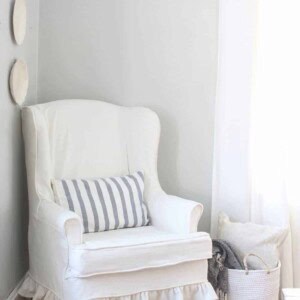
Equipment
- Sewing machine
Ingredients
- 100% cotton drop cloth
- sewing pins
Instructions
- For this slipcover I used painter’s drop cloth that I bleached (a process you can find on my blog!)
- This is not a quick process. You will want your chair near your sewing machine, so you can continually go back and forth to make sure everything is fitting okay. You never want to pin and sew several seams at one time. Always pin a little, sew it, and return to the chair to pin a little more. Taking care to go slowly will ensure an excellent fit!
- To begin, I made enough piping to get me through the whole project.
- To do this, I sandwiched 6/32″ cotton cord inside a four inch strip of bleached drop cloth. I used a zipper foot to get the needle as close to the cord as possible, without sewing over it.
- Next, I cut and draped all the pieces over the chair. (This will make waaay more sense in the video.) I cut pieces for the outside and inside of the wing, two pieces for the back, two pieces for the arms, two pieces for the front of the arms, two outside lower pieces, a piece for the front apron and a large piece for the front chair back (if that makes any sense at all).
- I totally guesstimated all the sizes of the pieces. Nothing has to be exact. The exactness will come with the pinning and sewing. I started by overlapping the two back pieces and pinning them (right sides together) to the chair back piece.It is really important to keep the chair back piece smooth and tight. It will the most visible in the finished slipcover.
- Following the lines and seams of the original chair, I pinned the outside wing pieces to the back and to the inside wing pieces, which I also pinned to the front of the chair piece.
Have I lost you? It will make sense in the video. - You can see how many pins I used in this process. I wanted to be sure they would follow the lines of the chair, ensuring a nice fit.
I made sure the pins created a line for me to sew along. - While slipcovering I stop several times to be sure everything is still fitting.Sometimes things may appear a bit wonky but might actually turn out when you pull it taut at another seam. And remember that mine looked like it wasn’t going well halfway through, but turned out totally fine!
- I could tell that I wasn’t going to have quite enough bleached drop cloth to finish my project, so I used unbleached drop cloth for the portion that would be hidden underneath the cushion. Notice in the photo below how all the seams of my slipcover are along the original seams of the chair. Use the piece as your guide. This will allow you to slipcover anything.
- After the main portion of the slipcover was finished, I added a ruffle and piping to the bottom edge to finish it off.
- For the cushion, I created an envelope style cover, as opposed to using a zipper. To make the pattern, I traced the shape of the cushion onto the drop cloth, leaving about a half inch on all sides for seam allowance. For the bottom part of the cushion I cut two pieces that would overlap each other for the cushion to fit inside.
- I also cut a long strip that would go around the center of the cushion to join together the top and bottom pieces, with piping sandwiched between. If you are on the fence about trying this, I encourage you to do it! As long as you go slow and check the fit often, you can totally do this.
Notes
- Follow the original seams and lines of the chair/couch/love seat
- If you are adding piping, use the original chair as your guide. Put it in all the places that the original maker of the chair put it.
- Pin the fabric tightly to the chair
- Use a lot of pins and sew often.
Nutrition information is automatically calculated, so should only be used as an approximation.
Pin it for later
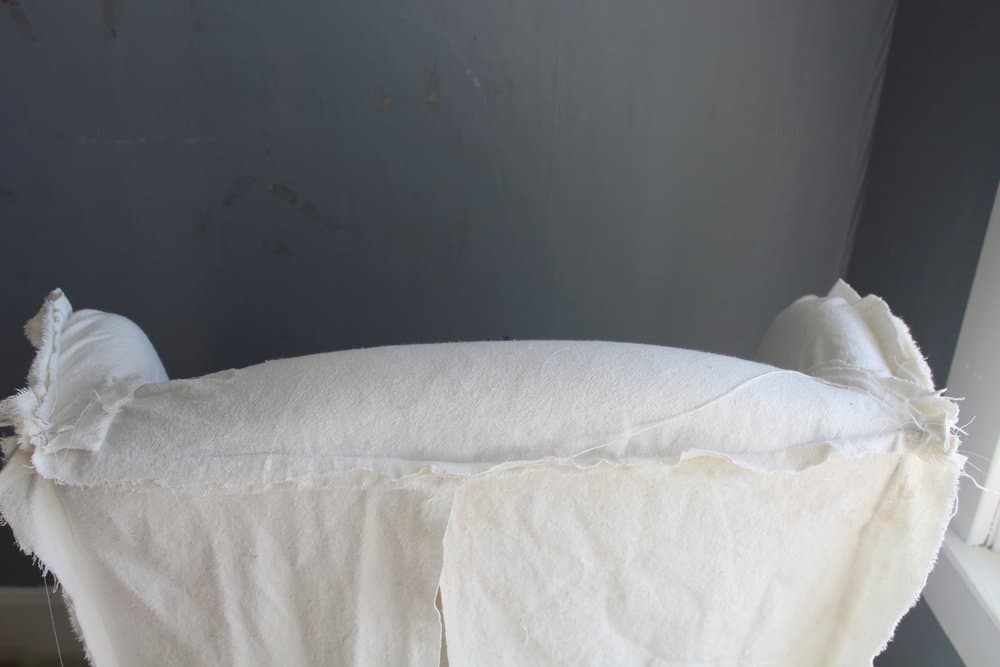
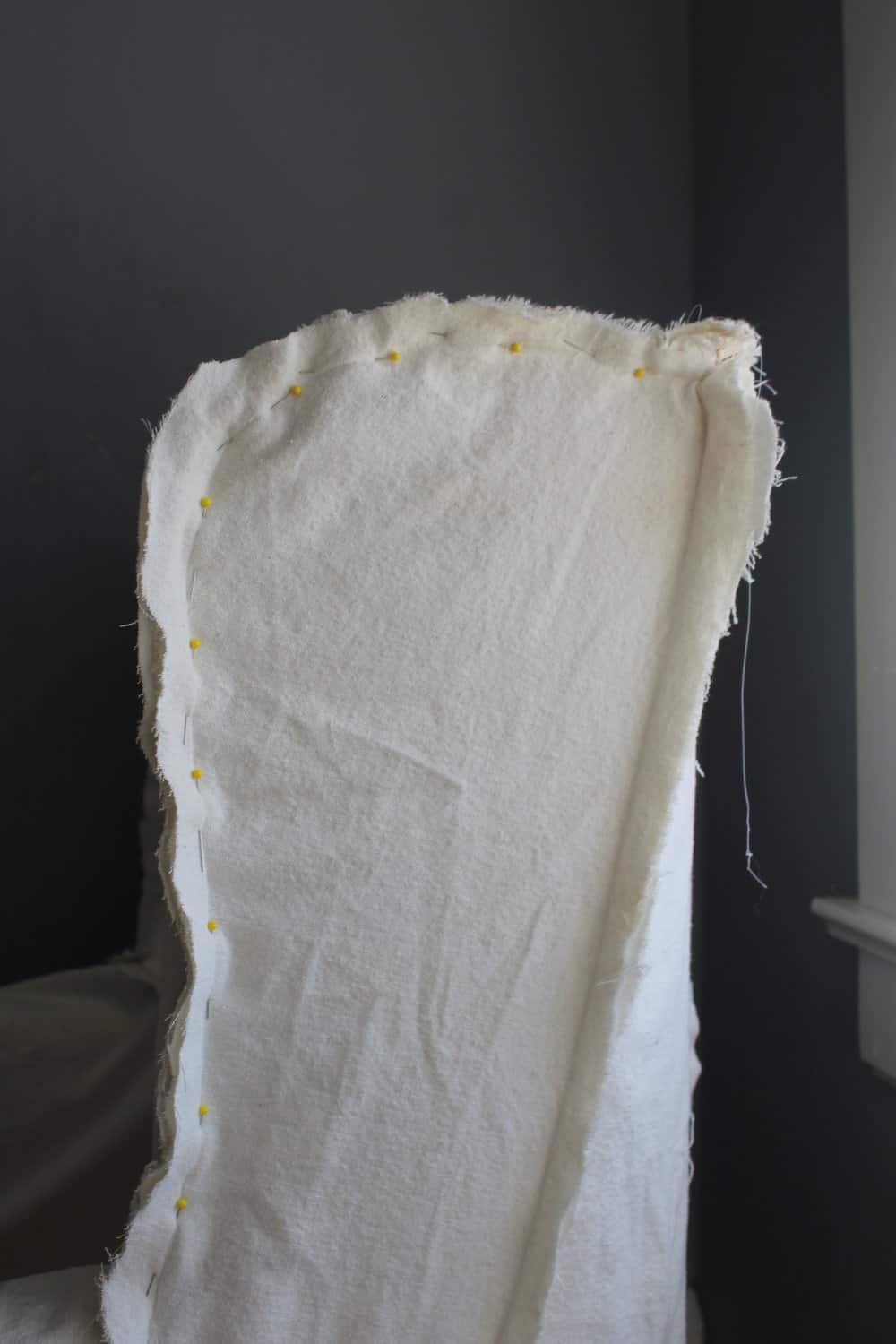
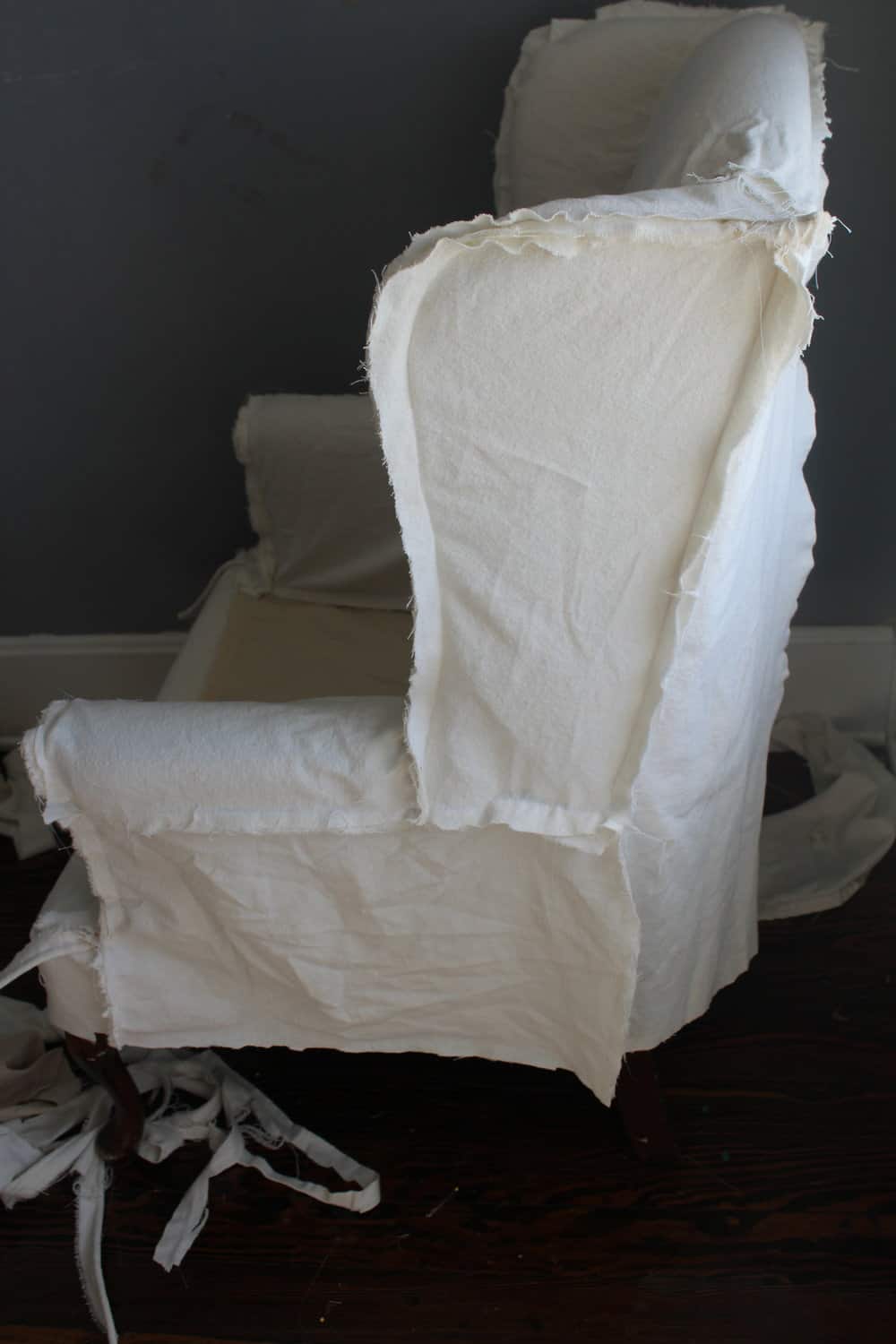
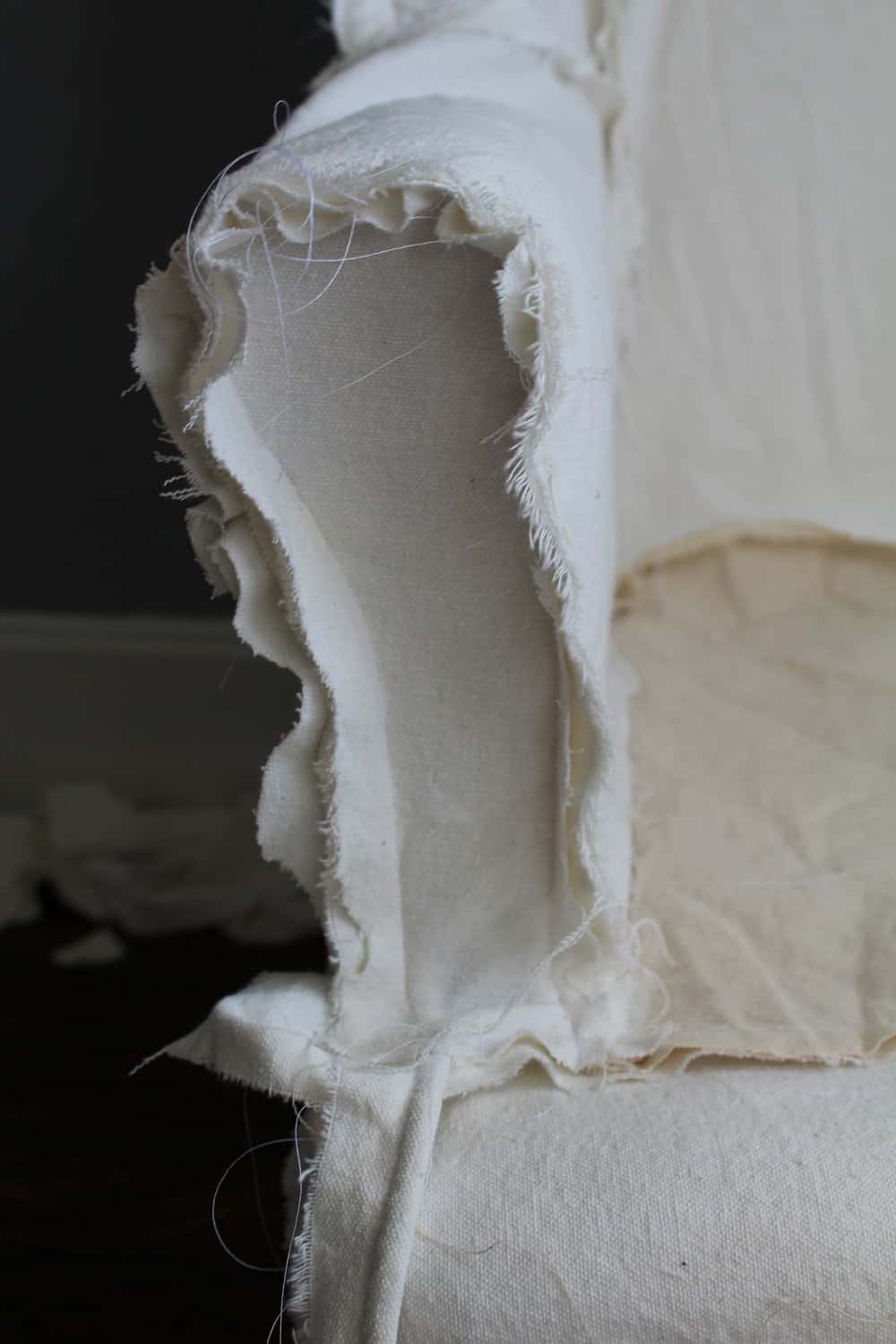
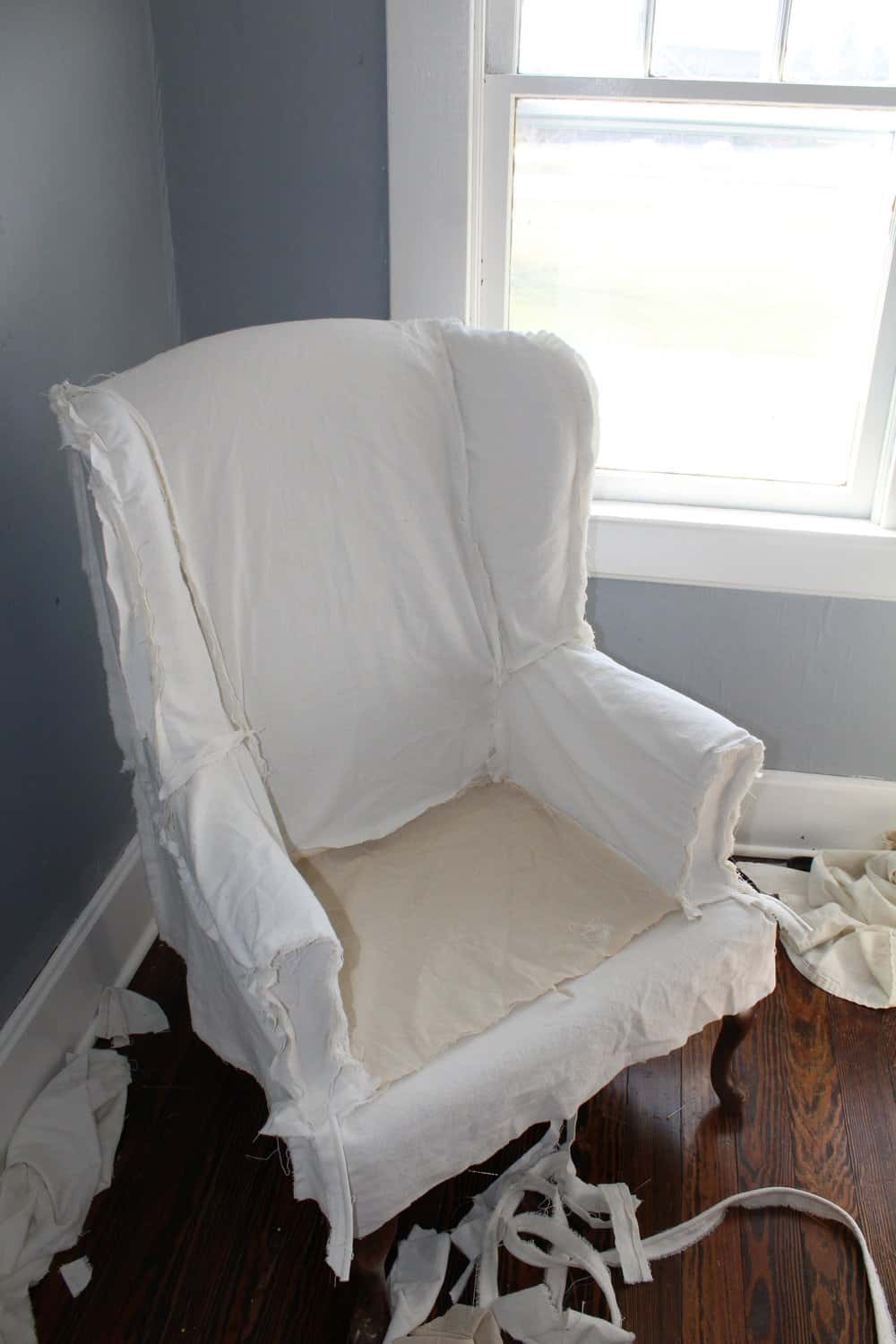
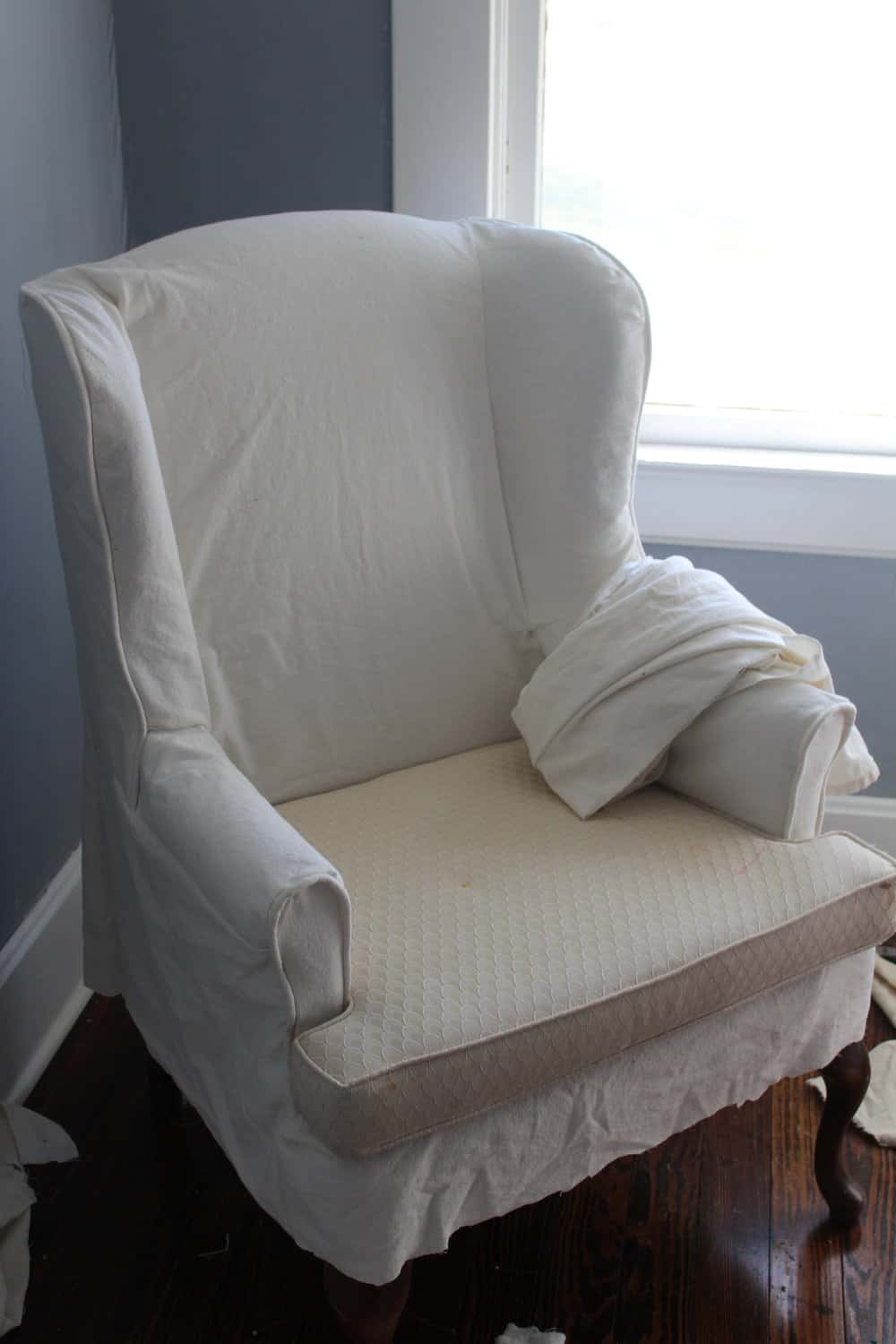
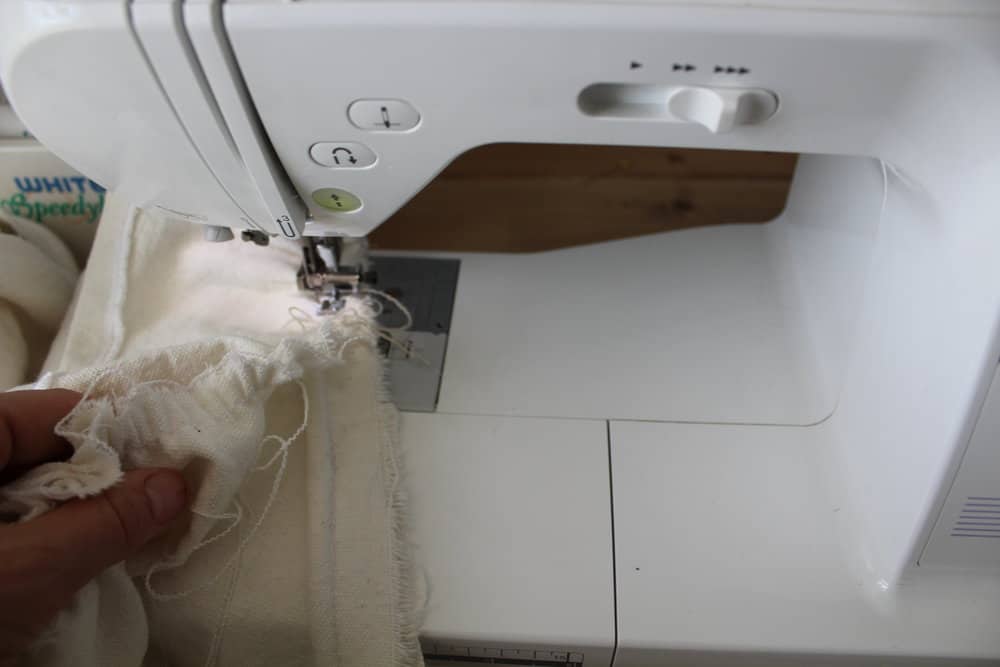
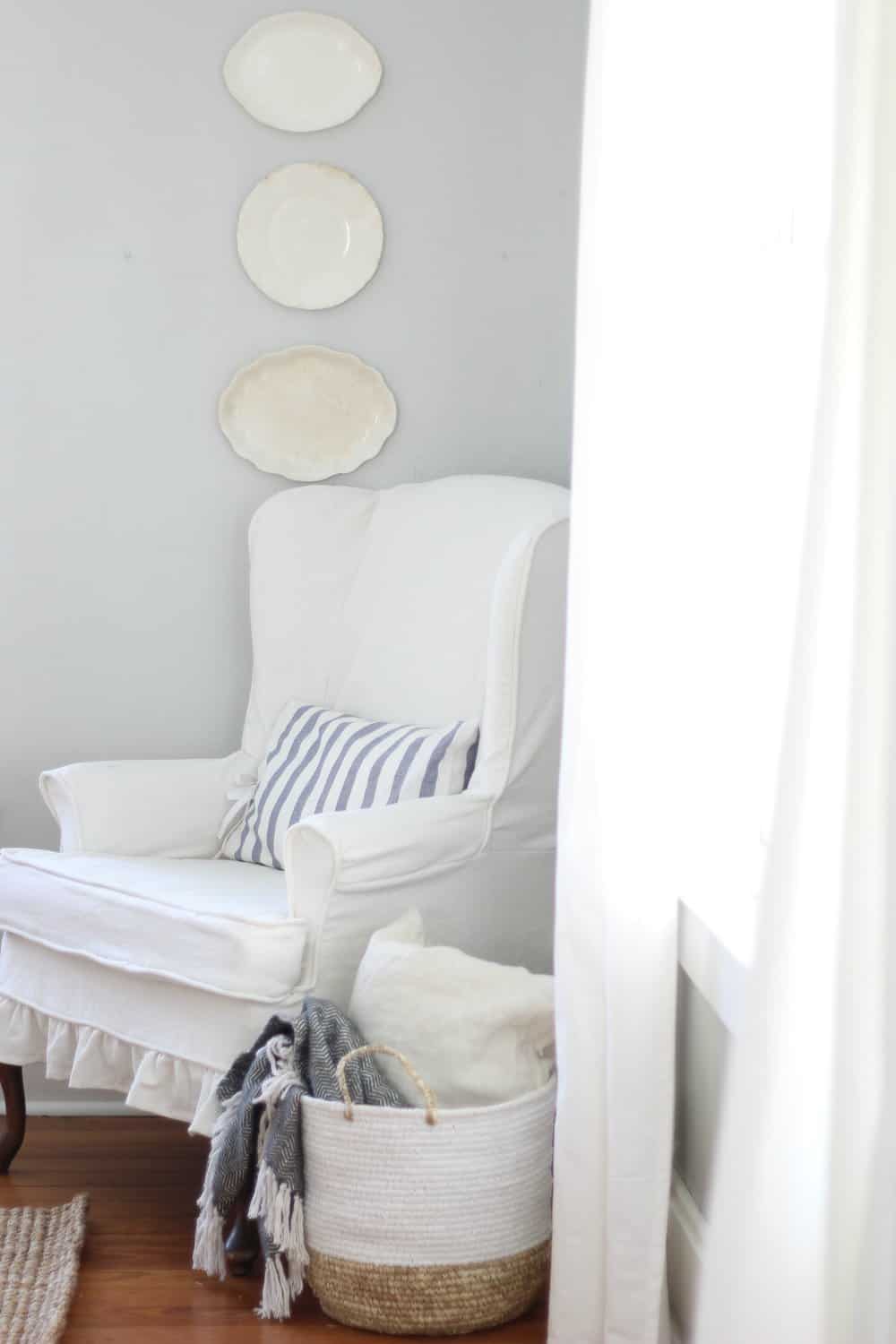
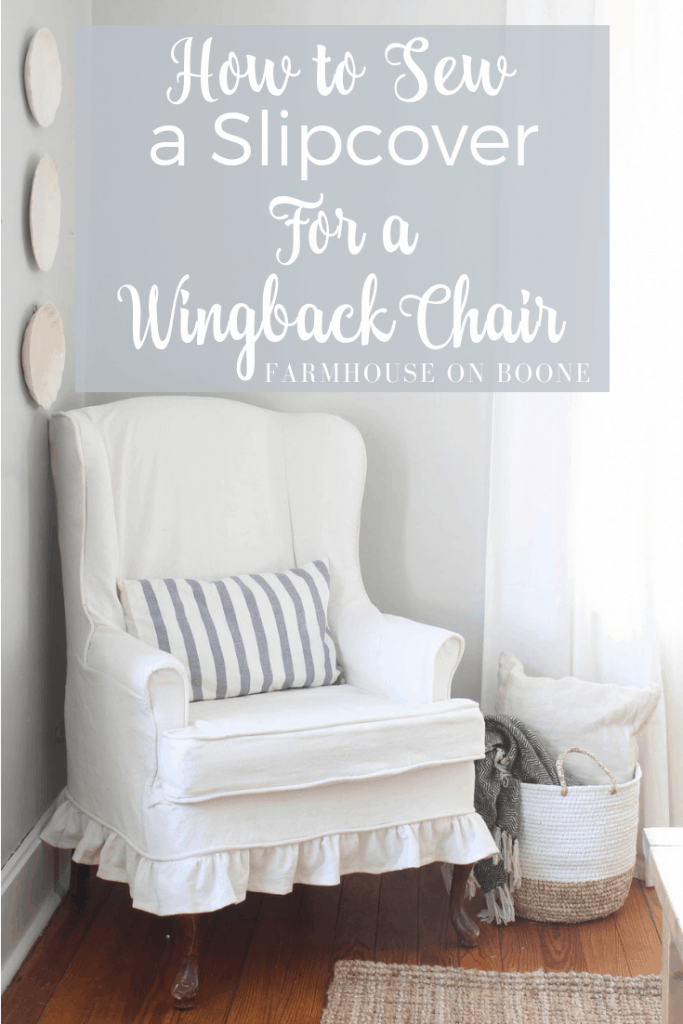
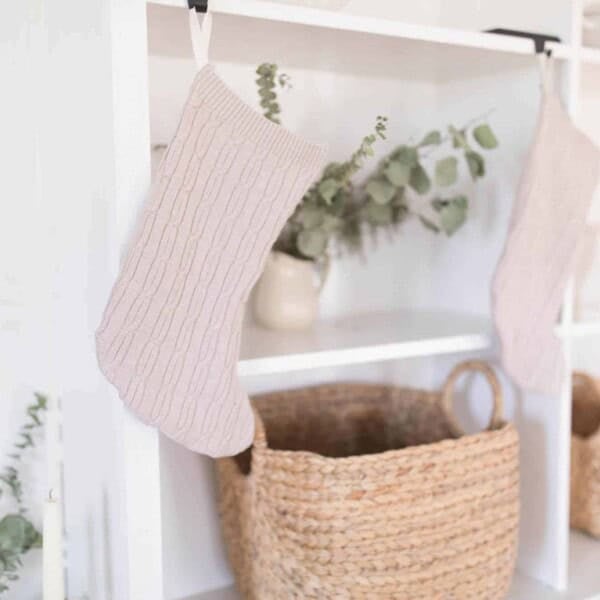


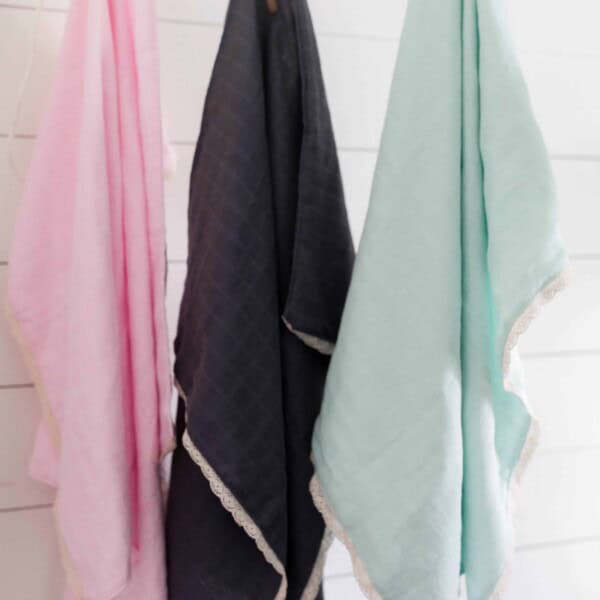






Thank you for the wonderful tutorial. You have inspired me to attempt making slipcover for my two wing back chairs. However, in my space, the back of the chairs are just as visible as the front. Could you show me the back of your finished chair, so I can see how you fastened the two halves of the back panel? I know there is more than one way to do it, but I would like to see how you did it. Thanks again for your through tutorial.
Can you show me the back of the finished slipcover and how you fastened the two back panels together? Your video has inspired me to attempt making my own slipcover. However, in my space, the back of the chair is just as visible as the front.
Thank you for you tutorial video. Love the envelope idea for seat cushion. I’m still confused on how the back of the wing chair comes together. Thank you, Kathe
Hi Lisa,
Thank You for your wonderful video tutorial. I am wondering how the slipcover stands up to dirt? I have teenagers and a dog that won’t stay off furniture. I’m assuming if there is visible dirt on the slipcover, one could use a product such as “shout” and bleach to remove the dirt or stain?
thanks,
Rose
Wee sounds
Dear Lisa, My mom has a couch , loveseat and recliner that I would like to slipcover. Do you have videos for these pieces?
Thank you,
Kim Alexander
Hi Kim,
I actually use the exact same technique for the couch and, since everything on goes on custom, the tutorial for those pieces would be the same. 🙂
HI and thank you for the wonderful video which I have followed as much as possible making a “trial” slipcover out of a sheet set before I cut into the painters cloth..however I have a sloped front to the arm of my wing chairs and the cover for it doesn’t look right . Could you please give me some suggestions on how to fit the slipcover to the arm front to make it look good…o , also the front of the chairs arm is covered in the nail heads that are used to decorate furniture…I can send you a picture if you like. Thank you again….
If you add nail heads you are doing more of an upholstery project than slipcovering. Email the pic to lisa@farmhouseonboone.com and I’ll check it out!
I am currently slipcovering my wingback chair. I’ve gotta tweak a few spots. I’m having trouble with the area where the wing meets the arms. I found that I didn’t need a zipper or opening to remove and put it on. 😊 Maybe since it’s pretty straight up and down. I saw on a site(maybe the slipcover maker) where she topstitched on each side of seam instead of cording. It’s a different look… I am liking it! It was so much easier! Thank you for your tutorial!
I wish I could see a picture of the finished back of the chair.
Your video or is helpful thanks for making it.
Hi! I love this tutorial you have put together. I’ve just passed the bleaching stage and I’m getting ready to make my piping. Should I wash and dry the cording in advance as well? It says it’s 100% cotton. I was just curious if you did before sewing. Thanks!
I’m thinking of trying this! What weight of 100% cotton canvas did you use? I see they come cotton thickness as low as 6 oz weight to a thicker 10 oz weight. Do you know what weight of cotton you used and if you would prefer a thicker (or thinner) material weight in retrospect?